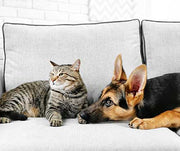Tips for Using A Pet Stroller

Have you ever passed someone pushing a stroller only to realize that there isn't a baby in the stroller – there's an animal? Seeing a cat or a dog riding in a stroller can be a funny and unusual sight. Believe it or not, there can be several benefits to pet strollers and many reasons why you may want to consider using one.
BENEFITS OF STROLLERS FOR DOGS
Strollers are a great option for dogs who may not be able to go for walks but still could use some fresh air and time outside. Senior dogs, dogs with injuries, or pups who are recovering from surgery are just a few examples of situations where a stroller might come in handy. Strollers can also be a good option for rescued dogs who struggle with anxiety by helping them feel safe while outdoors. If your pup can't go on walks for one reason or another, it doesn't mean they aren't able to spend time outside. Fresh air and new surroundings are important to their mental health and keep their senses stimulated.
BENEFITS OF STROLLERS FOR DOG OWNERS
There are actually some benefits of using a pet stroller for pet owners or people who have mobility issues. Walking with a leash can be a challenge if you have a dog who tends to pull or gets easily excited. A stroller will keep you in control without you getting tugged around.
Pet strollers can also be a good option for those who own multiple dogs and want to take them out at the same time. It's difficult to keep multiple leashes from getting tangled, so strollers are a great solution!
WHAT ABOUT CATS?
Strollers are a great option for cats as well! While it's usually safest to keep cats indoors, felines can benefit from fresh air just like dogs can. Cats typically don't walk well on leashes unless they've been harness trained, and may be easily scared or distracted by things outside, so a screened-in stroller is a great way to keep them safe.

HOW TO TRAIN MY PET TO USE A STROLLER
For dogs: Before you attempt to use a pet stroller with your dog, you'll want to get them used to it ahead of time. It's a good idea to start off in the house so that your dog has minimal distractions. Give them time to sniff and explore the stroller. Keep the wheels locked at first so that the stroller won't move, and when your pup seems a little more at ease, unlock the wheels and slowly push it around.

Once your dog seems used to the stroller, carefully pick them up and place them inside. Don't push the stroller around quite yet – give them a big of time to adjust to sitting in it. You may want to give them a treat or a favorite toy. After a little bit of time, slowly try pushing the stroller around the room. Your dog may be nervous at first and this is normal. It may take a few tries before they adjust to riding comfortably.
When you notice your dog acting more relaxed and content as you push them in the stroller, you can start to try short outdoor walks up and down your street or in quiet areas. After they are comfortable with this, you can slowly progress to longer outings. When taking your pup for a walk in their stroller, don't forget to make sure they are wearing their collar, and keep their leash handy when stopping to let them out.
For Cats: Just like with dogs, you'll want to make sure that your cat has time to get used to their pet stroller before you take them out for a walk in it. Allow plenty of time for your cat to investigate the stroller. Placing treats or toys near it is a great way to get them interested and help them to develop a positive association with it. Unlock the wheels after your cat has had time to explore to get them used to watching you roll the stroller around your place.
When you place your cat in their stroller, know that they may likely jump out at first. If this happens, try placing them in again and feeding them a treat if they seem to stay. However, if your cat is repeatedly jumping out and is not happy with being placed in it, you may need to stop and try again another day.
Once your cat seems comfortable with sitting in the stroller, you'll need to slowly practice closing the canopy with them inside. Your cat may get scared or feel trapped at first, so open and close the canopy a few times to get them accustomed to it. Use positive reinforcement such as praise and treats when your cat stays inside.
After some time adjusting, slowly roll them around inside your home to get them used to the movement. Just like with dogs, do this a few times before attempting to take them for a walk outside. When you do venture outside, it's a good idea to be sure your cat stays extra secure by wearing a harness and a leash.
CONCLUSION
It's important to note that going for a walk with your pet in their stroller is not a substitute for exercise. Remember that dogs and cats of all ages and abilities still need physical activity to stay happy and healthy. If walking on a leash is not an option, be sure you find some other fun ways to give them a workout, such as by playing fetch or other games that give them a chance to get a bit of movement in during the day.
Previous article

Next article

Related posts
View all-

What Can You Use Instead of Cat Litter?
Traditional cat litter is convenient, but it’s not the only option. Many cat owners look for alternatives to reduce waste, save money, or avoid chemicals found in clay-based kitty litter. Some options offer better odor control, while others are more eco-friendly or gentler on a cat’s paws.
Read Article -

How to Keep My Backyard Smelling Fresh
A clean backyard should smell fresh, unlike pet waste, smoke, or mold. Bad smells can linger, especially when dog poop, urine, or food scraps attract flies and bacteria. If your yard has a foul odor, it's time to take action. The first step is cleaning up pet feces, trash, or rotting food. A garden hose can wash away dirt and urine from artificial turf, patios, and decks. To neutralize odor, Use baking soda, white vinegar, and essential oils.
Read Article -

What Supplies Do First-Time Cat Owners Need?
Bringing home a new cat is exciting, but making them feel safe and comfortable takes more than love. First-time cat owners must prepare with the right supplies to ensure a smooth transition. From a litter box to cat food and a warm bed, having the basics ready can help your new kitty settle in faster. This guide covers everything a new cat owner needs to make their new pet feel at home.
Read Article



